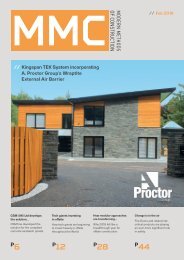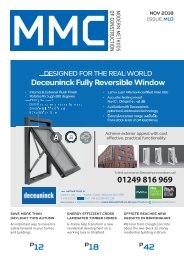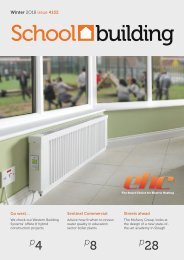R&R 8954 52 Nov '15 cc
You also want an ePaper? Increase the reach of your titles
YUMPU automatically turns print PDFs into web optimized ePapers that Google loves.
Washrooms & Kitchens |<br />
Changing places for equality<br />
Architects and designers could be<br />
exposing their clients to risk of breaking<br />
the law if they do not include a specific<br />
type of a<strong>cc</strong>essible toilet in new build or<br />
refurbishment projects.<br />
Under the Equality Act, which replaced the<br />
Disability Discrimination Act, service providers<br />
(including shops, tourist attractions, restaurants)<br />
are required to make reasonable changes –<br />
including to the built environment– where a<br />
disabled customer or potential customer would<br />
otherwise be at a substantial disadvantage. The<br />
Government’s own easy reference guide further<br />
states: “You should not wait until a disabled<br />
person experiences difficulties using a service.”<br />
For hundreds of thousands of the UK’s 11 million<br />
registered disabled, those who need a carer to<br />
help with personal care, conventional<br />
wheelchair-a<strong>cc</strong>essible toilets are unsuitable.<br />
“That means either having to lie on a toilet floor,<br />
often with the door open so anyone else can<br />
see you, or to go home, or not go out at all,”<br />
says Margaret Clough. “That puts my family, with<br />
my daughter Julie, at a substantial disadvantage,<br />
to use the Government’s terminology, as Julie is<br />
a severely disabled adult, in a wheelchair. Surely<br />
making one toilet bigger, and including a couple<br />
more pieces of equipment, is a reasonable<br />
change?”<br />
Margaret, her family and other similar families<br />
are petitioning venues as diverse as motorway<br />
services, hospitals, and tourist attractions to<br />
install Changing Places toilets. With more space<br />
than current wheelchair-a<strong>cc</strong>essible toilets, these<br />
also include as standard a hoist, adult-sized<br />
height adjustable changing table, and privacy<br />
screen.<br />
“You wouldn’t today expect to have to change a<br />
baby on the toilet floor, so why a child or<br />
adult?” asks Margaret. “There are over 8000<br />
public toilets in the UK, excluding ones we use<br />
in cafes, bars, at hospitals, tourist attractions.<br />
Yet there are fewer than 800 Changing Places<br />
toilets. There are at least 1.5million wheelchair<br />
users in the UK. One in 10 people suffers from<br />
bladder or bowel incontinence: There is clearly a<br />
need, and we would maintain adding these<br />
toilets on top of existing a<strong>cc</strong>essible facilities is a<br />
reasonable alteration.<br />
“Beyond the moral obligation, it has financial<br />
benefits too: 20% of the average business’<br />
customer base is disabled. Disabled people<br />
: For hundreds of<br />
thousands of the UK’s<br />
11 million registered<br />
disabled, those who<br />
need a carer to help<br />
with personal care,<br />
conventional<br />
wheelchair-a<strong>cc</strong>essible<br />
toilets are unsuitable.<br />
spend some £80billion a year! Research shows<br />
people choose NOT to use somewhere they<br />
believe does not have suitable toilets.”<br />
To help architects and facilities managers get<br />
their a<strong>cc</strong>essible toilets right, and meet Changing<br />
Places campaigners needs, leading disabled<br />
toilet solutions company Clos-o-Mat has<br />
developed the most comprehensive and a<br />
unique ‘one-stop shop’ solution.<br />
In-house, the company can provide design<br />
advice, then supply all the equipment, if<br />
necessary install and commission it, and<br />
subsequently service & maintain it. Full project<br />
management can also be provided. This is<br />
reinforced with support services including CAD<br />
blocks, and sector-specific advisory white<br />
papers available for free on its website<br />
www.clos-o-mat.com<br />
Exciting New Wet Zones from GEC Anderson<br />
48<br />
LEADING stainless steel specialist, GEC<br />
Anderson limited, have released details of an<br />
exciting new ‘wet zone’ concept.<br />
Available now, the new wet zone option<br />
enables specifiers to include a pressed recess<br />
anywhere within the stainless steel worktop<br />
area. Typically, the recess would be formed<br />
around sink bowl(s) but it can also be used to<br />
create lowered areas for other applications.<br />
For example, to locate chopping boards or to<br />
act as a general catchment area.<br />
The pressed recess detail is 3mm deep and can<br />
be formed in any size and position. It has a<br />
variable corner radius with a minimum radius<br />
of 10mm.<br />
refurb| RENEW <strong>Nov</strong>ember2O15 issue <strong>8954</strong><br />
Managing Director of GEC Anderson<br />
Limited, Martin Tye, comments: “This is an<br />
exciting new development that enables<br />
customers to specify wet zones, of any<br />
shape and size. Wet zones provide a real<br />
practical advantage and they look really<br />
neat as well. Because the recess can be<br />
formed to any pattern, it really does open<br />
the door to a lot of new creative<br />
opportunities for our customers.”<br />
GEC Anderson offer a number of different wet<br />
zone options of which the pressed recess is<br />
one. Tye continues “The pressed recess is also<br />
extremely cost effective. It is formed early in<br />
the production process, with a high level of<br />
automation. This makes it possible to contain<br />
the basic price to just under £150 and brings<br />
the wet zone concept within reach of many<br />
more of our customers.”<br />
Full details and information are available<br />
online at: www.gecanderson.co.uk<br />
or you can always call<br />
GEC Anderson on 01442 826999.

















